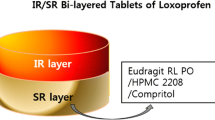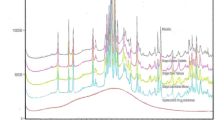Abstract
Purpose
Bepotastine besilate, a second-generation antihistamine commonly prescribed to treat allergic rhinitis and urticarial/pruritus, has a short half-life (t1/2) and is currently available as an immediate-release tablet, administered twice daily. The development of a sustained-release bepotastine formulation remains limited.
Methods
An experimental method was used to develop a sustained-release bepotastine tablet that can be taken once daily. The formulated sustained-release bepotastine tablet was biologically equivalent to the commercially available Talion® taken twice daily. Considering the target formulation characteristics, the in vitro dissolution rates at 1, 3, and 10 h were predicted as critical quality attributes, taking into account the dissolution and bioequivalence profile of Talion®.
Results
Factors capable of critically impacting the sustained-release pattern were selected by performing a screening study; the X value, which affects the Y value (1, 3, and 10 h dissolution rates), was identified using hydroxypropyl methylcellulose, polyvinyl-alcohol, and citric acid. For the three identified independent variables, a design space was derived using the extreme vertices design from among the experimental design mixture methods, optimized within the X values of the derived design space. The optimized formulation employed a direct compression process to minimize time and cost. The dissolution rates at 1, 3, and 10 h were 24.9, 47.4, and 88.8%, respectively, exhibiting an appropriate dissolution profile to induce sustained-release effects in the human body.
Conclusion
Bepotastine sustained-release tablet, which can be administered once daily, developed by applying the design of experiment method, was biologically equivalent to the Talion® tablet, which is administered twice daily. Therefore, the developed sustained-release technology using two or more hydrophilic polymers can be applied to various pharmaceuticals in the future as a platform to overcome the technical and commercial limitations of sustained-release agents.






Similar content being viewed by others
Data availability
Not Applicable.
References
Boyd BJ, Khoo S-M, Whittaker DV, Davey G, Porter CJ (2007) A lipid-based liquid crystalline matrix that provides sustained release and enhanced oral bioavailability for a model poorly water soluble drug in rats. Int J Pharm 340:52–60
Carrillo-Martin I, Gonzalez-Estrada A, Dimov V (2018) Bepotastine besilate for the treatment of perennial allergic rhinitis. Expert Opin Pharmacother 19:1727–1730
Cho KH, Choi H-G (2013) Development of novel bepotastine salicylate salt bioequivalent to the commercial bepotastine besilate in beagle dogs. Drug Dev Ind Pharm 39:901–908
Costa RDO, Coutinho JP, Santos RLSR (2022) Use of mixture design to optimize nanofabrication of dithiocarbazate–loaded polylactic acid nanoparticles. J Appl Polym Sci 139:51504
Damle M, Pardeshi K (2019) Development of analytical method to monitor dissolution of bepotastine besilate tablet. J Drug Deliv Therap 9:251–256
Davies NM, Takemoto JK, Brocks DR, Yáñez JA (2010) Multiple peaking phenomena in pharmacokinetic disposition. Clin Pharmacokinet 49:351–377
Habib BA, Abdeltawab NF, Salah Ad-Din I (2022) D-optimal mixture design for optimization of topical dapsone niosomes: in vitro characterization and in vivo activity against Cutibacterium acnes. Drug Deliv 29:821–836
Jeon S-W, Jin H-S, Park Y-J (2021) Formation o0f self-assembled liquid crystalline nanoparticles and absorption enhancement of Ω-3s by phospholipids and oleic acids. Pharmaceutics 14:68
Kida T, Fujii A, Sakai O, Iemura M, Atsumi I, Wada T, Sakaki H (2010) Bepotastine besilate, a highly selective histamine H1 receptor antagonist, suppresses vascular hyperpermeability and eosinophil recruitment in in vitro and in vivo experimental allergic conjunctivitis models. Exp Eye Res 91:85–91
Kim JY, Choi DH (2022) Quality by design approach with multivariate analysis and artificial neural network models to understand and control excipient variability. J Pharma Investig. https://doi.org/10.1007/s40005-022-00608-5
Kim K-A, Park J-Y (2013) Pharmacokinetic comparisons of bepotastine besilate and bepotastine salicylate in healthy subjects. Clin Drug Investig 33:913–919
Kim J-E, Park Y-J (2022) QbD consideration for developing a double-layered tablet into a single-layered tablet with telmisartan and amlodipine. Pharmaceutics 14:377
Kim H-A, Lee S-H, Park Y-J, Kim J-E (2021) Analysis of perception and status survey on the introduction of QbD system by pharmaceutical companies in Korea. Yakhak Hoeji 65:301–312
Lee S-H, Kim J-K, Jee J-P, Jang D-J, Park Y-J & Kim J-E (2022) Quality by Design (QbD) application for the pharmaceutical development process. J Pharma Investig., 1–34.
Mo JH, Jeong JH, Kim TH, Kim ST, Kim SW, Lee KH, Hong SN, Kim HY, Kim DW, Kim DY (2021) Double-blind placebo-controlled trial of bepotastine salicylate in patients with allergic rhinitis. Laryngoscope 131:E702–E709
Oh G-H, Kim J-E, Park Y-J (2018a) Development of stabilized tenofovir disoproxil tablet: degradation profile, stabilization, and bioequivalence in beagle dogs. Drug Dev Ind Pharm 44:757–766
Oh G-H, Park J-H, Shin H-W, Kim J-E, Park Y-J (2018b) Quality-by-design approach for the development of telmisartan potassium tablets. Drug Dev Ind Pharm 44:837–848
Okubo K, Ichimura M, Koyama T, Susuta Y, Izaki H (2015) Double-blind placebo-controlled study of bepotastine besilate in pediatric patients with perennial allergic rhinitis. Expert Opin Pharmacother 16:2395–2408
Park MS, Choi DH (2020) Application of mechanism-based modeling to predict drug quality during the pharmaceutical unit operations of granulation and compression: a review. J Pharm Investig 50:445–467
Paśko P, Rodacki T, Domagała-Rodacka R, Palimonka K, Marcinkowska M, Owczarek D (2017) Second generation H1-antihistamines interaction with food and alcohol—a systematic review. Biomed Pharmacother 93:27–39
Rai AK, Poojary S, Dubey L, Gupta P (2022) A double-arm, randomized, and controlled trial to compare the efficacy and safety of bepotastine with levocetirizine in patients of chronic spontaneous urticaria. Natl J Physiol Pharm Pharmacol 12:1216–1216
Sousa A, Serra J, Estevens C, Costa R, Ribeiro A (2022) A quality by design approach in oral extended release drug delivery systems: where we are and where we are going? J Pharm Investig. https://doi.org/10.1007/s40005-022-00603-w
Than YM, Titapiwatanakun V (2021) Statistical design of experiment-based formulation development and optimization of 3D printed oral controlled release drug delivery with multi target product profile. J Pharm Investig 51:715–734
Williams JI, Gow JA, Klier SM, Mccue SL, Salapatek AMF, Mcnamara TR (2010) Non-clinical pharmacology, pharmacokinetics, and safety findings for the antihistamine bepotastine besilate. Curr Med Res Opin 26:2329–2338
Yanai K, Rogala B, Chugh K, Paraskakis E, Pampura A, Boev R (2012) Safety considerations in the management of allergic diseases: focus on antihistamines. Curr Med Res Opin 28:623–642
Yanai K, Yoshikawa T, Yanai A, Nakamura T, Iida T, Leurs R, Tashiro M (2017) The clinical pharmacology of non-sedating antihistamines. Pharmacol Ther 178:148–156
Author information
Authors and Affiliations
Corresponding authors
Ethics declarations
Conflict of interest
All authors (S.W. Jeon, J.H. Park, J.E. Kim, and Y.J. Park) declare that they have no conflict of interest.
Research involving human or animal participants
All animal testing procedures complied with the Animal Welfare Act and the guidelines for the protection and use of experimental animals and were approved by the Animal Management and Use Committee of KPC, Korea (IRB No. P192021; Identification code: E2016063; Approval date: March 01, 2016).
Additional information
Publisher's Note
Springer Nature remains neutral with regard to jurisdictional claims in published maps and institutional affiliations.
Rights and permissions
Springer Nature or its licensor (e.g. a society or other partner) holds exclusive rights to this article under a publishing agreement with the author(s) or other rightsholder(s); author self-archiving of the accepted manuscript version of this article is solely governed by the terms of such publishing agreement and applicable law.
About this article
Cite this article
Jeon, SW., Park, JH., Kim, JE. et al. Design of experiment (DoE)-based formulation design of bepotastine sustained-release tablet and in vitro-in vivo pharmacokinetic correlation. J. Pharm. Investig. 53, 407–416 (2023). https://doi.org/10.1007/s40005-023-00611-4
Received:
Accepted:
Published:
Issue Date:
DOI: https://doi.org/10.1007/s40005-023-00611-4




